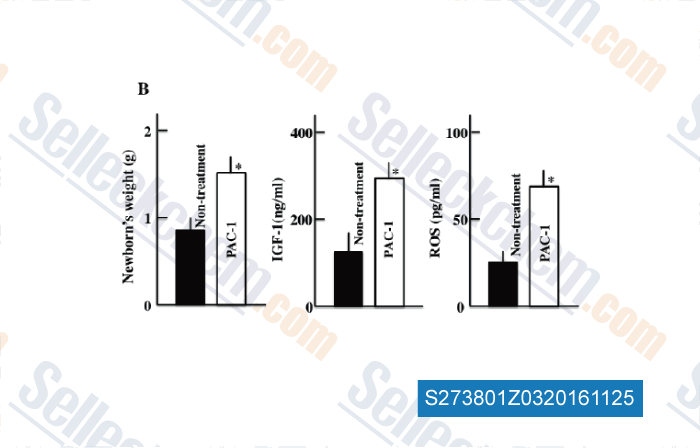|
Toll Free: (877) 796-6397 -- USA and Canada only -- |
Fax: +1-832-582-8590 Orders: +1-832-582-8158 |
Tech Support: +1-832-582-8158 Ext:3 Please provide your Order Number in the email. |
Technical Data
| Formula | C23H28N4O2 |
|||
| Molecular Weight | 392.49 | CAS No. | 315183-21-2 | |
| Solubility (25°C)* | In vitro | DMSO | 78 mg/mL (198.73 mM) | |
| Water | Insoluble | |||
| Ethanol | Insoluble | |||
|
* <1 mg/ml means slightly soluble or insoluble. * Please note that Selleck tests the solubility of all compounds in-house, and the actual solubility may differ slightly from published values. This is normal and is due to slight batch-to-batch variations. * Room temperature shipping (Stability testing shows this product can be shipped without any cooling measures.) |
||||
Preparing Stock Solutions
Biological Activity
| Description | PAC-1 is a potent procaspase-3 activator with EC50 of 0.22 μM and the first small molecule known to directly activate procaspase-3 to caspase-3. | ||
|---|---|---|---|
| Targets |
|
||
| In vitro | PAC-1 activates procaspase-7 in a less efficient manner with EC50 of 4.5 μM. Elevated caspase 3 level in cancer cell lines allows PAC-1 to selectively induce apoptosis in a manner proportional to procaspase-3 concentration with IC50 of 0.35 μM for NCI-H226 cells to ~3.5 μM for UACC-62 cells. PAC-1 induces apoptosis in the primary cancerous cells with IC50 values of 3 nM to 1.41 μM, more potently than in the adjacent noncancerous cells with IC50 of 5.02 μM to 9.98 μM, which is also directly related to the distinct procaspase-3 concentration. [1] PAC-1 activates procaspase-3 by chelating zinc ions, thus relieving the zinc-mediated inhibition and allowing procaspase-3 to auto-activate itself to caspase-3. [2] PAC-1 is capable to induce cell death in Bax/Bak double-knockout cells and Bcl-2 and Bcl-xL-overexpressing cells with the same efficacy as its wild-type counterpart in a delayed manner. PAC-1 induces cytochrome c release in a caspase-3 independent manner, which subsequently triggers downstream caspase-3 activation and cell death. PAC-1 can not induce cell death and caspase-3 activation in Apaf-1 knockout cells, suggesting that apoptosome formation is essential for caspase-3 activation by PAC-1-mediated cell death. [3] | ||
| In vivo | Administration of PAC-1 at 5 mg with low and steady releasing significantly inhibits the growth of ACHN renal cancer xenograft in mice. Oral administration of PAC-1 (50 or 100 mg/kg) significantly retards tumor growth of NCI-H226 lung cancer xenograft in a dose-dependent manner, and markedly prevents the cancer cells from infiltrating the lung tissue. The in vivo anti-tumor effect of PAC-1 is ascribed to procaspase-3 activation and subsequently apoptosis induction consistent with the activity in vitro. [1] | ||
| Features | The first small molecule known to directly activate procaspase-3 to caspase-3. |
Protocol (from reference)
| Kinase Assay:[1] |
|
|---|---|
| Cell Assay:[1] |
|
| Animal Study:[1] |
|
References
|
Customer Product Validation

-
Data from [Data independently produced by , , Biol Med, 2015, 7(5).doi: 10.4172/0974-8369.1000259.]
Selleck's PAC-1 has been cited by 17 publications
| Aedes aegypti Argonaute 2 controls arbovirus infection and host mortality [ Nat Commun, 2023, 14(1):5773] | PubMed: 37723154 |
| Aedes aegypti Argonaute 2 controls arbovirus infection and host mortality [ Nat Commun, 2023, 14(1):5773] | PubMed: 37723154 |
| Caspase 3 exhibits a yeast metacaspase proteostasis function that protects mitochondria from toxic TDP43 aggregates [ Microb Cell, 2023, 10(8):157-169] | PubMed: 37545643 |
| PEBP balances apoptosis and autophagy in whitefly upon arbovirus infection [ Nat Commun, 2022, 13(1):846] | PubMed: 35149691 |
| COL8A1 Promotes NSCLC Progression Through IFIT1/IFIT3-Mediated EGFR Activation [ Front Oncol, 2022, 12:707525] | PubMed: 35280763 |
| ANP32E contributes to gastric cancer progression via NUF2 upregulation [ Mol Med Rep, 2022, 26(3)275] | PubMed: 35795988 |
| Modulating environmental signals to reveal mechanisms and vulnerabilities of cancer persisters [ Sci Adv, 2022, 8(4):eabi7711] | PubMed: 35089788 |
| Microbes exploit death-induced nutrient release by gut epithelial cells [ Nature, 2021, 10.1038/s41586-021-03785-9] | PubMed: 34349263 |
| The Zebrafish Antiapoptotic Protein BIRC2 Promotes Edwardsiella piscicida Infection by Inhibiting Caspases and Accumulating p53 in a p53 Transcription-Dependent and -Independent Manner [ Front Immunol, 2021, 12:781680] | PubMed: 34887869 |
| Cooperative application of transcriptomics and ceRNA hypothesis: LncRNA-107052630/miR-205a/G0S2 crosstalk is involved in ammonia-induced intestinal apoptotic injury in chicken. [ J Hazard Mater, 2020, 18;396:122605] | PubMed: 32334290 |
RETURN POLICY
Selleck Chemical’s Unconditional Return Policy ensures a smooth online shopping experience for our customers. If you are in any way unsatisfied with your purchase, you may return any item(s) within 7 days of receiving it. In the event of product quality issues, either protocol related or product related problems, you may return any item(s) within 365 days from the original purchase date. Please follow the instructions below when returning products.
SHIPPING AND STORAGE
Selleck products are transported at room temperature. If you receive the product at room temperature, please rest assured, the Selleck Quality Inspection Department has conducted experiments to verify that the normal temperature placement of one month will not affect the biological activity of powder products. After collecting, please store the product according to the requirements described in the datasheet. Most Selleck products are stable under the recommended conditions.
NOT FOR HUMAN, VETERINARY DIAGNOSTIC OR THERAPEUTIC USE.
